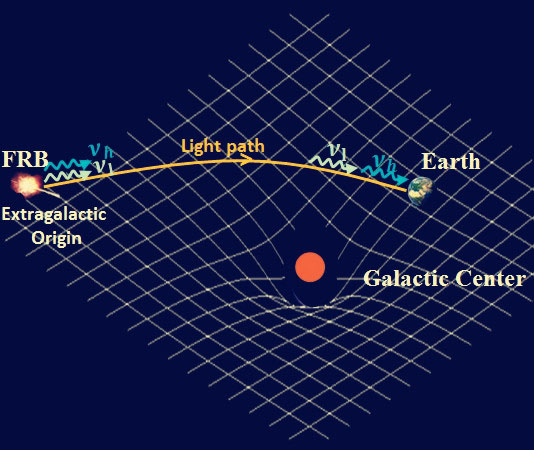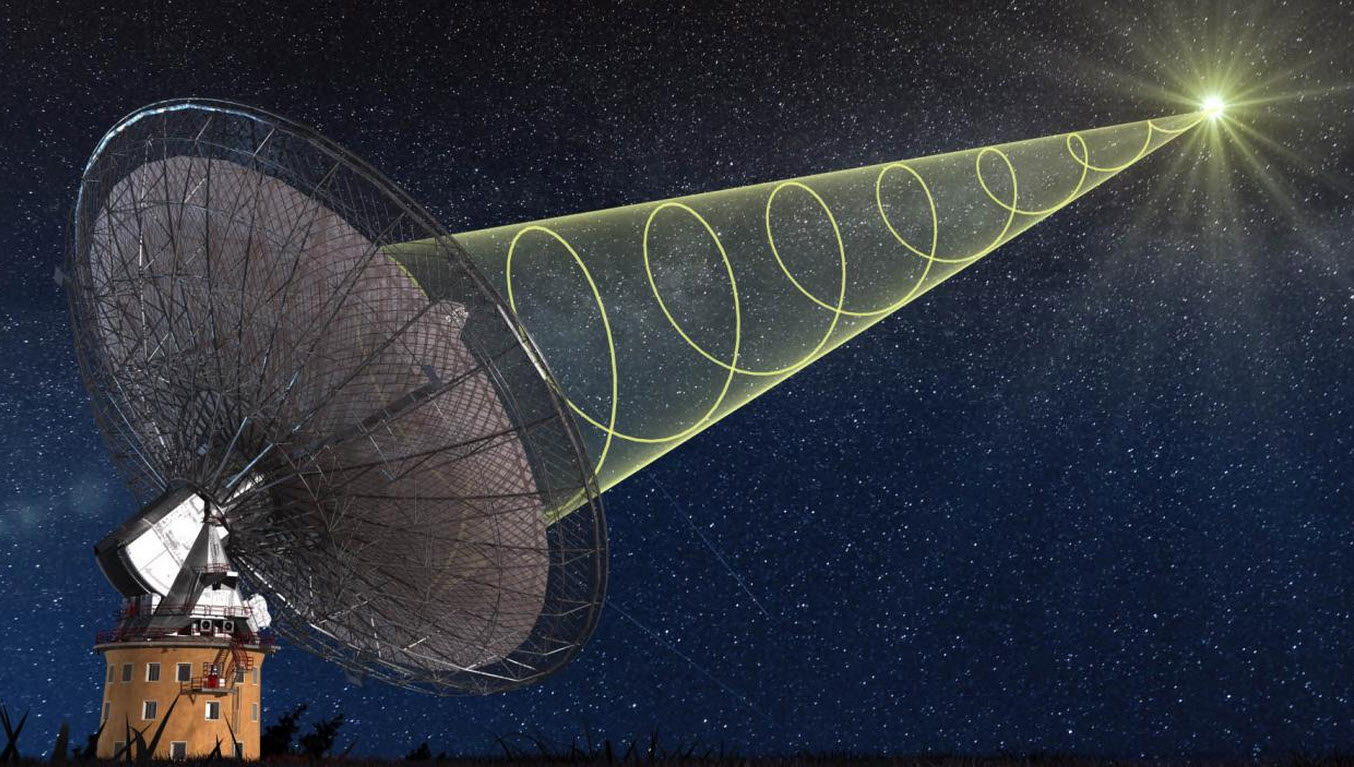‘Fast radio burst’ signals from space a better test of Einstein’s General Relativity theory
January 7, 2016

This illustration shows how two photons, one at a high frequency (blue wave) and another at a low frequency (yellow wave), travel in curved space-time from their origin in a distant fast radio burst (FRB) source until reaching the Earth. A lower-limit estimate of the gravitational pull that the photons experience along their way is given by the mass (red) in the center of the Milky Way Galaxy. (credit: Purple Mountain Observatory, Chinese Academy of Sciences)
Physicists have developed a new way to test one of the basic principles underlying Einstein’s theory of General Relativity, which states that the geometry of spacetime is curved by the mass density of individual galaxies, stars, planets, and other objects.
The new method uses brief blasts of rare radio signals from space called fast radio bursts (FRBs) (see “Mysterious cosmic burst of radio waves detected by astronomers” and “Arecibo detects mystery radio burst from beyond our galaxy“). These FRBs have achieved up to 100 times better results than previous testing methods that used gamma-ray bursts, according to a paper published in the journal Physical Review Letters.

A schematic illustration of CSIRO’s Parkes radio telescope receiving a polarized signal from a “fast radio burst” (credit: Swinburne Astronomy Productions)
Fast radio bursts are super-brief blasts of energy lasting just a few milliseconds. Until now, only about a dozen FRBs have been detected on Earth. They appear to be caused by mysterious events beyond our Milky Way Galaxy, and possibly even beyond the Local Group of galaxies that includes the Milky Way.
“If Fast Radio Bursts are proven to originate outside the Milky Way Galaxy, and if their distances can be measured accurately, they will be a new powerful tool for testing Einstein’s Equivalence Principle and for extending the tested energy range down to radio-band frequencies,” said Peter Mészáros, Holder of the Eberly Family Chair in Astronomy and Astrophysics and Professor of Physics at Penn State, the senior author of the research paper.
Testing Einstein’s Equivalence Principle
Einstein’s Equivalence Principle requires that any two photons of different frequencies, emitted at the same time from the same source and traveling through the same gravitational fields, should arrive at Earth at exactly the same time. “If Einstein’s Equivalence Principle is correct, any time delay that might occur between these two photons should not be due to the gravitational fields they experienced during their travels, but should be due only to other physical effects,” Mészáros said. “By measuring how closely in time the two different-frequency photons arrive, we can test how closely they obey Einstein’s Equivalence Principle.”
Specifically, Mészáros said the test that he and his coauthors developed involves an analysis of how much space curvature the photons experienced due to massive objects along or near their path through space.
Mészáros said his research team’s analysis of the less-than-a-dozen recently detected Fast Radio Bursts “supersedes by one to two orders of magnitude the previous best limits on the accuracy of the Einstein Equivalence Principle,” which were based on gamma rays and other energies from a 1987 supernova explosion. “Our analysis using radio frequencies shows that the Einstein Equivalence Principle is obeyed to one part in a hundred million,” Mészáros said.
This research is supported, in part, by the National Basic Research Program of China, NASA, the National Natural Science Foundation of China, and the Chinese Academy of Sciences.
Abstract of Testing Einstein’s Equivalence Principle With Fast Radio Bursts
The accuracy of Einstein’s equivalence principle (EEP) can be tested with the observed time delays between correlated particles or photons that are emitted from astronomical sources. Assuming as a lower limit that the time delays are caused mainly by the gravitational potential of the Milky Way, we prove that fast radio bursts (FRBs) of cosmological origin can be used to constrain the EEP with high accuracy. Taking FRB 110220 and two possible FRB/gamma-ray burst (GRB) association systems (FRB/GRB 101011A and FRB/GRB 100704A) as examples, we obtain a strict upper limit on the differences of the parametrized post-Newtonian parameter γ values as low as [γ(1.23 GHz)−γ(1.45 GHz)]<4.36×10−9. This provides the most stringent limit up to date on the EEP through the relative differential variations of the γparameter at radio energies, improving by 1 to 2 orders of magnitude the previous results at other energies based on supernova 1987A and GRBs.